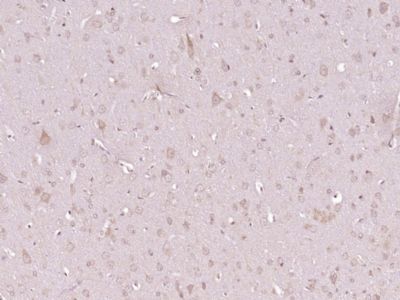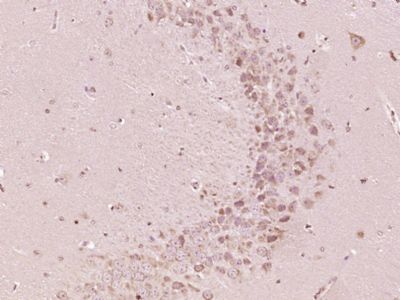Otoferlin Polyclonal Antibody
Purified Rabbit Polyclonal Antibody (Pab)
- 产品详情
- 实验流程
Application
| IHC-P, IHC-F, IF, ICC |
|---|---|
| Primary Accession | Q9HC10 |
| Reactivity | Rat, Dog, Bovine |
| Host | Rabbit |
| Clonality | Polyclonal |
| Calculated MW | 226753 Da |
| Physical State | Liquid |
| Immunogen | KLH conjugated synthetic peptide derived from human Otoferlin |
| Epitope Specificity | 1601-1700/1997 |
| Isotype | IgG |
| Purity | affinity purified by Protein A |
| Buffer | 0.01M TBS (pH7.4) with 1% BSA, 0.02% Proclin300 and 50% Glycerol. |
| SUBCELLULAR LOCATION | Cytoplasmic vesicle > secretory vesicle > synaptic vesicle membrane. Basolateral cell membrane. Endoplasmic reticulum membrane. Cell membrane. Detected at basolateral cell membrane with synaptic vesicles surrounding the ribbon and at the presynaptic plasma membrane in the inner hair cells (IHCs). Colocalizes with GPR25 and RAB8B in inner hair cells. |
| SIMILARITY | Belongs to the ferlin family. Contains 4 C2 domains. |
| DISEASE | Defects in OTOF are the cause of deafness autosomal recessive type 9 (DFNB9) [MIM:601071]. DFNB9 is a form of sensorineural hearing loss. Sensorineural deafness results from damage to the neural receptors of the inner ear, the nerve pathways to the brain, or the area of the brain that receives sound information. Defects in OTOF are a cause of non-syndromic auditory neuropathy autosomal recessive (NSRAN) [MIM:601071]. NSRAN is a form of sensorineural hearing impairment with absent or severely abnormal auditory brainstem response but normal otoacoustic emissions. Auditory neuropathies result from a lesion in the area including the inner hair cells, connections between the inner hair cells and the cochlear branch of the auditory nerve, the auditory nerve itself and auditory pathways of the brainstem. In some cases NSRAN phenotype can be temperature sensitive. |
| Important Note | This product as supplied is intended for research use only, not for use in human, therapeutic or diagnostic applications. |
| Background Descriptions | Mutations in this gene are a cause of neurosensory nonsyndromic recessive deafness, DFNB9. The short form of the encoded protein has 3 C2 domains, a single carboxy-terminal transmembrane domain found also in the C. elegans spermatogenesis factor FER-1 and human dysferlin, while the long form has 6 C2 domains. The homology suggests that this protein may be involved in vesicle membrane fusion. Several transcript variants encoding multiple isoforms have been found for this gene. [provided by RefSeq, Jul 2008] |
| Gene ID | 9381 |
|---|---|
| Other Names | Otoferlin, Fer-1-like protein 2, OTOF, FER1L2 |
| Target/Specificity | Isoform 1 and isoform 3 are found in adult brain. Isoform 2 is expressed in the fetus and in adult brain, heart, placenta, skeletal muscle and kidney. |
| Dilution | IHC-P=1:100-500,IHC-F=1:100-500,ICC=1:100-500,IF=1:100-500 |
| Format | 0.01M TBS(pH7.4) with 1% BSA, 0.09% (W/V) sodium azide and 50% Glyce |
| Storage | Store at -20 °C for one year. Avoid repeated freeze/thaw cycles. When reconstituted in sterile pH 7.4 0.01M PBS or diluent of antibody the antibody is stable for at least two weeks at 2-4 °C. |
| Name | OTOF |
|---|---|
| Synonyms | FER1L2 |
| Function | Key calcium ion sensor involved in the Ca(2+)-triggered synaptic vesicle-plasma membrane fusion and in the control of neurotransmitter release at these output synapses. Interacts in a calcium-dependent manner to the presynaptic SNARE proteins at ribbon synapses of cochlear inner hair cells (IHCs) to trigger exocytosis of neurotransmitter. Also essential to synaptic exocytosis in immature outer hair cells (OHCs). May also play a role within the recycling of endosomes (By similarity). |
| Cellular Location | Cytoplasmic vesicle, secretory vesicle, synaptic vesicle membrane {ECO:0000250|UniProtKB:Q9ESF1}; Single-pass type II membrane protein {ECO:0000250|UniProtKB:Q9ESF1}. Basolateral cell membrane {ECO:0000250|UniProtKB:Q9ESF1}; Single-pass type II membrane protein {ECO:0000250|UniProtKB:Q9ESF1}. Endoplasmic reticulum membrane {ECO:0000250|UniProtKB:Q9ESF1}; Single-pass type II membrane protein {ECO:0000250|UniProtKB:Q9ESF1}. Golgi apparatus membrane {ECO:0000250|UniProtKB:Q9ESF1}; Single-pass type II membrane protein {ECO:0000250|UniProtKB:Q9ESF1}. Presynaptic cell membrane {ECO:0000250|UniProtKB:Q9ESF1}; Single-pass type II membrane protein {ECO:0000250|UniProtKB:Q9ESF1}. Cell membrane {ECO:0000250|UniProtKB:Q9ESF1}; Single-pass type II membrane protein {ECO:0000250|UniProtKB:Q9ESF1}. Note=Detected at basolateral cell membrane with synaptic vesicles surrounding the ribbon and at the presynaptic plasma membrane in the inner hair cells (IHCs) at postnatal day 30 (P30). Colocalizes with GPR25 and RAB8B in inner hair cells {ECO:0000250|UniProtKB:Q9ESF1} |
| Tissue Location | Isoform 1 and isoform 3 are found in adult brain. Isoform 2 is expressed in the fetus and in adult brain, heart, placenta, skeletal muscle and kidney |
Research Areas
For Research Use Only. Not For Use In Diagnostic Procedures.
Application Protocols
Provided below are standard protocols that you may find useful for product applications.
终于等到您。ABCEPTA(百远生物)抗体产品。
点击下方“我要评价 ”按钮提交您的反馈信息,您的反馈和评价是我们最宝贵的财富之一,
我们将在1-3个工作日内处理您的反馈信息。
如有疑问,联系:0512-88856768 tech-china@abcepta.com.























 癌症的基本特征包括细胞增殖、血管生成、迁移、凋亡逃避机制和细胞永生等。找到癌症发生过程中这些通路的关键标记物和对应的抗体用于检测至关重要。
癌症的基本特征包括细胞增殖、血管生成、迁移、凋亡逃避机制和细胞永生等。找到癌症发生过程中这些通路的关键标记物和对应的抗体用于检测至关重要。 为您推荐一个泛素化位点预测神器——泛素化分析工具,可以为您的蛋白的泛素化位点作出预测和评分。
为您推荐一个泛素化位点预测神器——泛素化分析工具,可以为您的蛋白的泛素化位点作出预测和评分。 细胞自噬受体图形绘图工具为你的蛋白的细胞受体结合位点作出预测和评分,识别结合到自噬通路中的蛋白是非常重要的,便于让我们理解自噬在正常生理、病理过程中的作用,如发育、细胞分化、神经退化性疾病、压力条件下、感染和癌症。
细胞自噬受体图形绘图工具为你的蛋白的细胞受体结合位点作出预测和评分,识别结合到自噬通路中的蛋白是非常重要的,便于让我们理解自噬在正常生理、病理过程中的作用,如发育、细胞分化、神经退化性疾病、压力条件下、感染和癌症。







